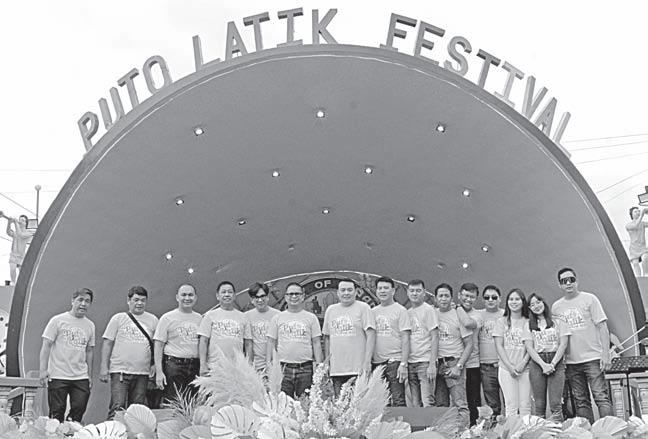
9 minute read
BACK WITH A VENGEANCE BIñAN CElEBr ATEs 13TH PuTo lATIK FEsTIVAl
By Roderick L. Abad | Contributor
Photos by Bernard Testa
“If there’s ‘revenge travel,’ this is our ‘revenge festival,’” Biñan City Mayor Walfredo “Arman” Dimaguila, Jr. told the media during the opening ceremony of the nine-day festivity, which started from May 15 to 23.
According to him, the festivity did not only showcase the “beauty, unity and skills” of Biñanenses, but it also highlighted the “transformation of the city” through the years.
“There may be many challenges still, but with the help of the Sangguniang Panglungsod, Congresswoman Marlyn ‘Le’ Alonte-Naguiat and Vice Mayor Angelo ‘Gel’ Alonte, I can see the transformation and transition will be even better,” he said.
“We may have witnessed that the primary movers of Puto Latik Festival were the local government and the Biñan City Culture, History, Arts and Tourism Office [BCHATO], but we also see the involvement of the people that’s very important,” he added.
This, in turn, resulted to the revelry’s success, as shown in the massive turnout of the people who came and see live the various activities lined up all throughout its duration.
Without citing the exact figures, BCHATO Head Bryan Jayson “BJ” Borja was positive that they have met, if not surpassed, their target number of visitors for this year’s fair.
“The arrival of tourists last year, if I’m not mistaken, was at 45,000,” he said of the total volume of participation in their previous hybrid event.
“Because this year’s edition runs for nine days, hopefully, we can exceed that. I would be very happy if it’s at least 46,000.”
Such estimate is a big help to achieve Biñan’s goal of welcoming “half-a-million” tourists by the end of 2023, per Mayor Dimaguila.
“We want to improve more on the numbers, not only of the locals, but also visitors from our neighboring cities and municipalities and even abroad,” he emphasized.
Origin of festivity
SINCE its inception in 2010, the Puto Latik Festival has become the source of pride of the City of Biñan. People within and outside the province of Laguna looks forward to it every year to see the vast culture and traditions of the so-called “City of Life.”
True to its name, the festivity lauds and fosters its very own Puto Biñan and folk war dance, popularly known as “maglalatik,” dedicated and offered to San Isidro Labrador, the
The Metamorphosis Of The M
patron saint of farmers and the local government unit (LGU).
Originally, it was observed every first week of February. But because the city was formerly called the Hacienda de San Isidro Labrador de Biñan during the Spanish regime, it is but appropriate to have it in connection to agriculture. Thus, the festival was moved to the feast day of the religious icon, which falls every 15th day of May.
Event highlights
NOT veering away from its tradition, the 13th Puto Latik Festival, themed “Makiisa, Makisaya, Makisayaw,” started with a holy rite to pray for its success through the Karakol ng Reyna ng Biñan, a symbolic visit of the image of the Nuestra Señora de la Paz y Buen Viaje (declared as the Honorary Queen of Biñan through City Resolution 19-2018) to the San Isidro Labrador Catholic Church, the city’s mother church, in Barangay Poblacion.
This was followed by the Misang Bayan. Immediately after, the city’s top officials called the “Big Three”— Mayor Dimaguila, Vice Mayor Alonte and Congresswoman Alonte-Naguiat—led the grand opening at the newly-opened Plaza Rizal.
In his keynote speech, the local chief executive shared the initiatives and plans of the LGU to strengthen the local tourism industry by way of reviving the rich culture and heritage of Biñan.
The kick off day started to spark the interest for the entire festival with the inter-community costume, drum beating and street dance parades and competitions. With the creatively designed outfit worn by its representative, Barangay Canlalay achieved a back-to-back win for the costume contest. Tribo Magayon’s upbeat performance earned for it the champion - ship title of the drum beating category, as Barangay Dela Paz won the street dance search.
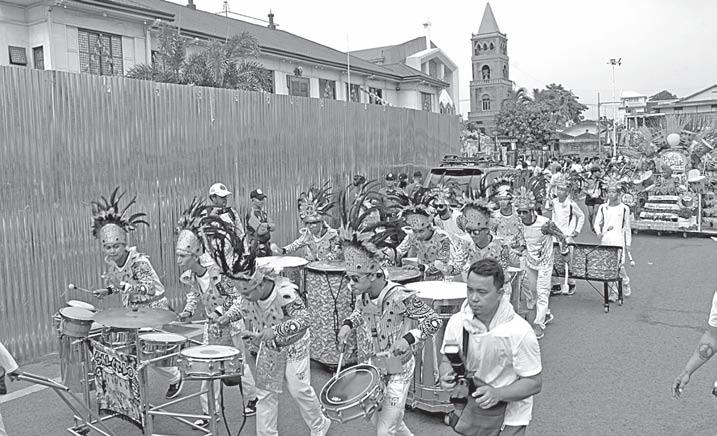
Other talents of Biñanenses were feted, with the grand winners in their respective competitions: Jericho Apil of Barangay Canlalay for the Singing Idol; Barangay Santo Tomas, Land Float; Arvin Rallos, Flair Challenge; Barangay Santo Domingo, Cook-Off Challenge; and Raw Blox, Barangay Langkiwa, Modern Dance Showdown.
The City of Life Awards were given to Barangay Mamplasan as the Top
1 Most Business-Friendly Barangay Award. Outstanding companies were also accorded with the recognition for their exemplary accomplishments and contributions to the city’s economic growth and development.
Not to be ignored, of course, were the beauty and intelligence of its people. After going through stringent trainings, workshops, community engagements and various activities, Carlos Alberto Tipon of Barangay Dela Paz and his equally dashing and smart female counterpart Angela Meygan Muramatsu of Barangay San Francisco were crowned Mister and Miss Biñan 2023. For the LGBTQ Plus sector, Billy Jones Narvaez of Barangay Malaban was named the Miss Biñan Gay Queen 2023. They will serve as the city’s tourism ambassadors during their reigns.
Overall, the Puto Latik Festival overall champion was Barangay Dela Paz. This was followed by barangays Santo Domingo, Malaban, Canlalay, and Langkiwa, accordingly. Athletic and wellness activities were held to promote sportsmanship and camaraderie. For entertainment, there were open cinema and arts concert featuring all the groups under the Biñan City Centre for Performing Arts Inc. Learning about the local culture was brought about by a forum.
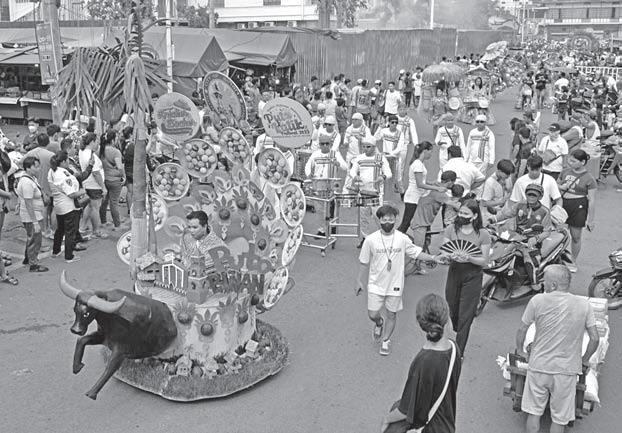
Iconic art museum remains a must-visit in new location
Story & photos
by Benjamin Locsin Layug
One of my regrets was I never got to visit the old Metropolitan Museum of Manila, an art museum that exhibits local and international contemporary art, that was formerly located in a building designed by Gabriel Formoso. Located within the Bangko Sentral ng Pilipinas (BSP) Complex along Roxas Boulevard in the Malate d istrict of M anila, it billed itself as the country’s premier museum for modern and contemporary visual arts by local and international artists. Fret not, for though this building is now permanently closed, the museum has just transferred to a new location.
The Met first opened its doors in 1976 with an initial exhibit of international artists to expose Filipinos to contemporary visual works in other cultures. The first exhibit showcased 105 artworks, in various media, from the Brooklyn Museum and other American museums and galleries. Partly subsidized by the BSP, the museum’s administration was entrusted, in 1979, to the Metropolitan Museum of
Manila Foundation. By 1986, its focus shifted to local works, extending its reach to more common people by offering bilingual exhibition texts and developing several outreach educational programs like workshops and symposia, thereby promoting local pride and identity. Then came the Covid-19 pandemic.
During the pandemic and lockdown, the museum quickly transitioned its exhibitions and workshops online, with successful virtual exhibition openings and live conferences. At the same time, the famed institution was also gearing for another transition, arranged and made possible by the Chairman of its Board of Trustees, Joselito Y. Campos Jr.
In the last few decades, the nearby important galleries and hangouts in Manila have closed down, moving to Makati and, later, to Taguig, plus the original home of 45 years was already deemed inaccessible by many. Thus, the foundation decided to leave and move the museum to its new location in Bonifacio Global City, an emerging cultural hub in Taguig City, as an integral part of the office and commercial building of the Mariano K. Tan Center. The venue is near the sports park Track 30th and the High Street commercial center.
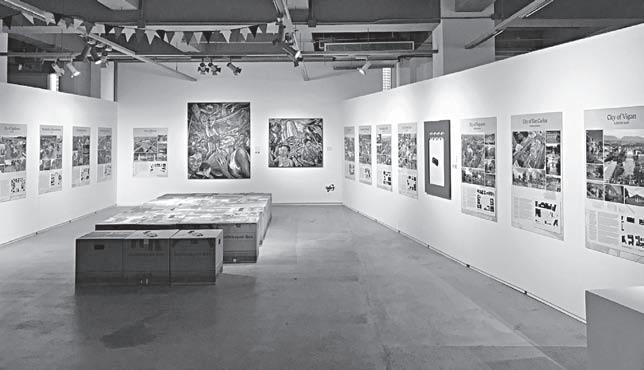
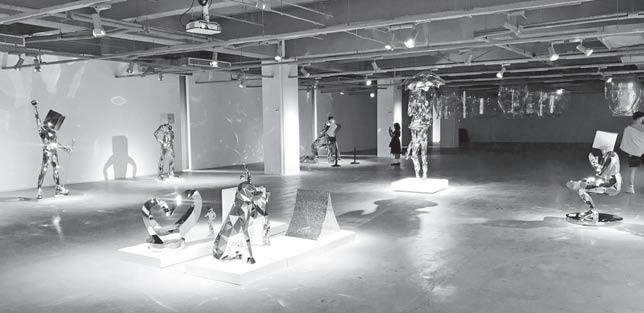
Fully opened to the public in February 2023, it also got a new nickname—the short, catchy, and easily recognizable The M, plus a new logo to better herald the beginning of a new era for the institution. Prior to its opening, it launched a preview of the new spaces with three exhibitions—“Ronald Ventura: Quick Turns on Hyper Highways,””Korea: A Land of Hats (presented in partnership with the Korean Cultural Center in the Philippines and the Coreana Cosmetics Museum) and “The Hat of the Matter” (supported by Bench, a global clothing brand).
Its brand new, state-of-the-art 3,000sq-m space, plus an outdoor area for installations, was designed by the Manila-born, Brooklyn-based Filipino-Columbian architect Carlos Arnaiz. The entrance of the museum is accessed through an open pedestrian walkway that leads to the bustling and often busy Bonifacio High Street area of shops and dining places. n o w with access to more foot traffic, the museum will now be introduced to a new audience, thus reinforcing its philosophy of “Art for All.”
As of this writing, the “Ronald Ventura:
Quick Turns on Hyper Highways,” at the ground floor, is still ongoing. Upon entering the third floor, you are greeted by “Anito,” a towering 8-ft. high aluminum artwork, in rust finish, by the late Arturo Luz that took 8 people to transport into the space where it stands. There are three ongoing exhibits there.
“Plazas in the Philippines: Places of Memory, Places of the Heart,” curated by landscape architect and urban planner Paulo G. Alcazaren, highlights 16 plazas across the Philippines in celebration of their role as the beating heart of many a town and city.
The “Jefre: Points of Origin” e x hibit, the first solo museum show of USA-based Filipino-American artist Jefre in the country, is a celebration of the monumentality of the artist’s accomplishments, and a way of connecting his two facets, his two homes: that of his origins and the home of his American dream.
The “Sounds of Blackness” e x hibition, a powerful group exhibition curated by Larry Ossei-Mensah, brings together a diverse group of visual artists from the African Diaspora whose practices articulate a multiplicity of ideas and perspectives through
Besides the amusement and fun it brought to the public, the city government extended various services to the public. These include a jobs fair and different missions held by the respective offices of Biñan’s top officials. The Tatak Gel Caravan provided free haircut, manicure, pedicure, eye check-up, bunot and dental check-up. The Alagang Len Caravan gave free Tesda trainings, pneumococcal vaccine, blood chemistry testing, and Alagang Len Card. Serbisyong Arman Caravan conducted medical missions and also legal services.
“So technically we are bringing down our services to the constituents. Like now, more than 2,000 have been already given free cataract operations. This and other initiatives are continuous. We will also launch soon our other projects, such as the new Biñan City Hospital, City Jail, and Cultural Center. We will also constantly improve out public markets and build more schools, among others,” Mayor Dimaguila bared.
Concluding the nine-day festivity with a bang were the grandiose religious parade of Santacruzan and the Pistang Intsik. With the strong Chinese traders’ roots in Biñan, the latter celebrates the legacy of its Chinese communities whose pivotal role helped create the distinct identity of both of the town and of its people.
“Unfortunately, they have dispersed and migrated to other parts of the country. So this long-standing tradition has slowly died down. So we looked at significant date. Hence, we open the festival with Pistang Bayan and close it with Pistang Intsik. It’s our way of helping the tradition of Pistang Intsik revived,” Borja explained.
With another tremendous success of this annual affair, it is yet expected to bring more laurels, adding to its roster of accolades, such as the Best
Tourism Events in the Philippines under the Best Tourism Event Festival Category (city level) in 2018, 2019 and 2022 from the Association of Tourism Officers of the Philippines-Department of Tourism Pearl Awards, and the distinction for the City of Biñan as the Most Outstanding Local Government Unit in Laguna for Culture and Tourism 2022 by the Provincial Government. “Festivals and these kinds of activities ignite the feelings of pride of people of their place and own identity. We hope that Biñanenses will own the festival because it is truly embedded in our culture and history,” he said.
Proud of the milestones of this yearly event, Mayor Dimaguila promised to bring more success in the coming years and appealed for its continuity to his predecessor.
“The name of the Puto Latik Festival should never change every time there’s a new administration,” he said.
“That’s why I think it’s good to have ‘Transformation’ and ‘Transition’ as the themes of next two Puto Latik Festivals under my term.”
Believing in the triumphs of the festivity for giving honors to the city, Vice Mayor Alonte, on his part, ensured for its continuity, as well as the other endeavors of the incumbent leadership if given the chance to lead the City of Biñan in the future. He said: “We also need to add more programs for the benefit of our constituents.”
Appreciative of the participation of the local government and the local residents, Mayor Dimaguila is positive that the two remaining years of his tenure service would be the best years of his administration.
“And that would improve more in the coming years because in the City of Biñan, the people are reliable,” he stressed.






